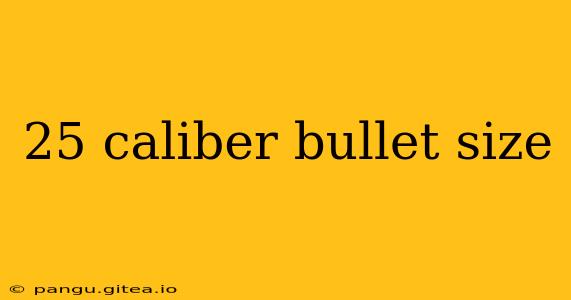The .25 ACP (Automatic Colt Pistol) cartridge, also known as the 6.35mm Browning, is a small-caliber handgun round. Understanding its bullet size and associated characteristics is crucial for anyone interested in this particular ammunition. This guide delves into the specifics of the .25 caliber bullet size, its applications, and important considerations.
Understanding .25 Caliber Bullet Dimensions
The .25 caliber bullet size refers to the diameter of the projectile, which is approximately 0.25 inches (6.35 millimeters). This is a relatively small diameter compared to other handgun calibers, leading to several implications regarding its capabilities and limitations.
Key Dimensions & Variations:
While the nominal diameter is 6.35mm, slight variations can exist depending on the manufacturer and specific bullet design. These minor differences usually fall within acceptable tolerances and don't significantly affect performance. Factors such as bullet shape (round nose, hollow point, etc.) and overall cartridge length also contribute to the overall dimensions.
Applications of the .25 ACP Cartridge
The .25 ACP's small size and relatively low recoil make it suitable for specific applications:
- Self-Defense (with caveats): While some may carry it for self-defense, its stopping power is significantly limited. It's crucial to understand its limitations and to prioritize proper training and situational awareness.
- Pocket Pistols: Its compact size makes it ideal for pocket pistols, offering concealability. However, this is often at the expense of power and accuracy.
- Target Shooting: It's suitable for close-range target practice, particularly for beginners learning firearm safety and handling.
Limitations of .25 Caliber Ammunition
It's essential to acknowledge the limitations of .25 ACP ammunition:
- Limited Stopping Power: The small bullet size and low energy transfer result in limited stopping power. This means it may not be effective in stopping a threat quickly.
- Short Effective Range: Accuracy and effectiveness diminish significantly at longer ranges.
- Penetration: Penetration capabilities are also limited, posing challenges in self-defense situations requiring penetration through barriers or clothing.
Choosing the Right Ammunition
When selecting .25 ACP ammunition, consider:
- Bullet Type: Different bullet types (e.g., full metal jacket, hollow point) offer varied performance characteristics.
- Manufacturer Reputation: Choose reputable ammunition manufacturers known for consistent quality and reliable performance.
- Intended Use: Your intended use (target shooting versus self-defense) should guide your ammunition selection.
Safety Considerations
Always handle firearms and ammunition responsibly. Proper training, safe storage, and adherence to all relevant safety regulations are paramount. Remember, even seemingly small calibers like .25 ACP can be dangerous if mishandled.
Conclusion
The .25 caliber bullet size represents a niche segment in the handgun ammunition market. Its small size and low recoil are attractive for specific applications, but users must fully understand its limitations regarding stopping power and effective range. Prioritize safety and responsible handling when using .25 ACP ammunition. Always seek professional training before handling any firearm.
